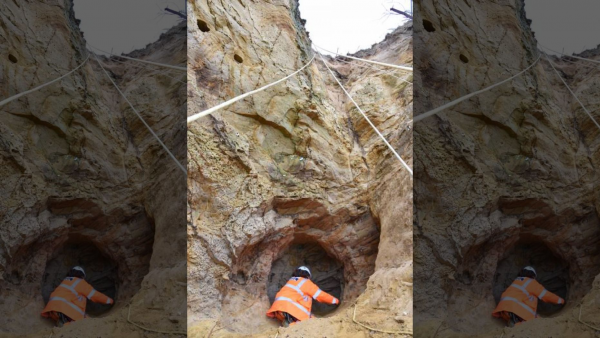England – Crew Stumbles Upon Medieval Shrine in Mysterious Cave

England is such an ancient land, with thousands of years of civilization behind it, that it’s not surprising that, almost every time workers plunge a backhoe or shovel into the earth, an archaeological treasure reveals itself.
That’s precisely what happened when a team of construction workers began repairing a railroad in Surrey, England, discovered a 14th century cave, complete with ancient drawings inside.
Network Rail, owner and operator of Britain’s railway infrastructure, had sent workers to the Surrey area to begin upgrades to some of the structure and equipment there that needed updating.
They barely got the project going, however, when they came upon the remains of a 14th century sandstone cave with several different sections, some only 0.4 metres high, while other sections stand 0.7 metres.
The company issued a statement on its website on April 8th saying that the cave had been, at one time, almost certainly much bigger. But when railway construction began in the 1840s, much of the cave was altered or buried to make way for what was a new form of transportation.
Network Rail brought in archaeology experts from Archaeology South East to examine the cave and the seven or eight sections of it still extant.
Those experts say that it may have been a shrine during the Medieval period, and was perhaps even associated with the 14th century chapel of Saint Catherine that is located nearby.
The sections, or “niches” as the archaeologists call them, have drawings from various eras, including the Gothic period. The specialists also noted that much of the cave floor was dusted in soot, likely from lamps used in it many centuries ago.

Now, of course, there are questions about how the upgrades to the railway infrastructure will proceed while bearing in mind the importance of preserving this historical site.
A spokesman for the company, Mark Killick, said in the statement released on their website that the company plans to make “every effort” to ensure that the cave and its drawings are not damaged when work ensues.
A detailed record, including photographs, has been done of the cave’s contents, and more preservation is underway to keep the site as safe as possible.
The company plans to work around the sandstone wherever feasible, it confirmed, in order to leave as much of the remains in good condition as worker possibly can.
One individual who is also thrilled by the find is Surrey county archaeologist Tony Howe, who is also the area’s environment planning manager.

On the Network Rail website, Howe said the discovery is “tremendously exciting,” and that he is certain all appropriate measures will be taken to maintain the site’s integrity.
He noted that, “it’s very early in the process of understanding its full significance, but the potential for knowledge acquisition is huge.”
Our archaeologists were recently called in to investigate a MYSTERY CAVE that was discovered following a landslip.
They found 14th C carvings and engravings likely part of a #medieval shrine or hermitage related to nearby St Catherine’s Church!https://t.co/fuE7gcrE3V pic.twitter.com/XvEcLdl4Kd
— UCL Archaeology South-East (is WFH) (@ArchSouthEast) April 7, 2020
That is an archeologist’s way of saying he can’t wait to discover all this historic site has to teach not only him, but everyone.
In addition to taking photos of the cave and drawings inside, Network Rail and its archaeology team has begun collecting samples from within the cave to ship away for analysis by lab experts, including charcoal and soot from its floor.
That is just one more step underway to learn all they can about this ancient cave, when it was built precisely, how it was used, and by whom.
It is just the kind of project archaeologists live for, and the kind of challenge on which they thrive: How to preserve an ancient ruin in the midst of a modern transportation hub?
An Incredible Artifacts From Lost Viking ‘highway’ Revealed by Melting Ice
The U.K. has had lots of practise with just this sort of conundrum, and no doubt the academics, archaeologists, rail personnel and construction workers will combine their skills, expertise and imaginations to find the best solution.
